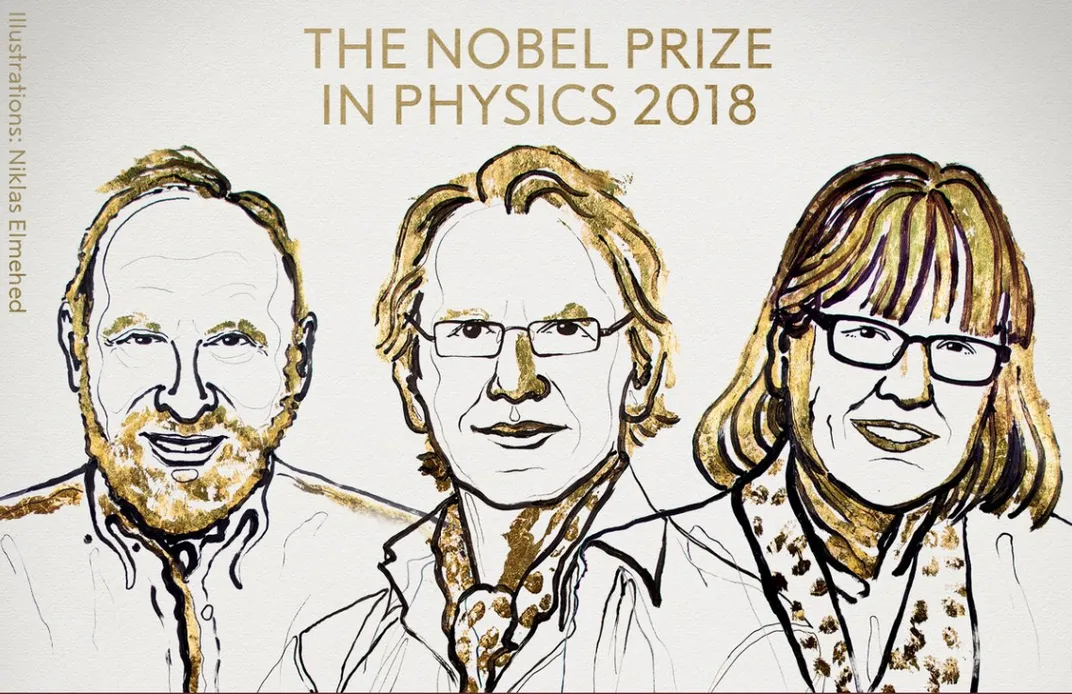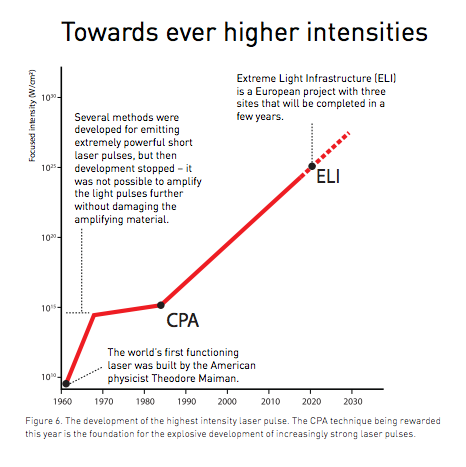The Nobels Notoriously Overlook Women Physicists. Donna Strickland’s Win Puts That Disparity into the Spotlight
Nobel committee recognizes three physicists in total, all of whom contributed to advancing laser technology
/https://tf-cmsv2-smithsonianmag-media.s3.amazonaws.com/filer/64/10/64107abd-0219-484c-8291-a60fe37d44e6/ap_18275708298282.jpg)
The first scientific publication Donna Strickland ever authored in 1985 with her supervisor revolutionized lasers used to conduct physics experiments. Today, she was honored with a Nobel for her contributions to that innovation, joining two others selected for the 2018 Physics prize for their work creating "tools made of light."
With the award, Strickland becomes the third woman in history to join the ranks of the now 210 Physics laureates. The last time the award was presented to a woman occurred 55 years ago, when Maria Goeppert-Mayer received the 1963 award for her contribution to discovering atomic nuclei structure. Goeppert-Mayer’s own win broke a 60-year dry streak left after the first woman to ever win the prize, Marie Curie, was named a Nobel Laureate in 1903 for her breakthrough co-discovery of radiation. When asked how she felt to be among such an exclusive group of women awardees, Sarah Kaplan at the Washington Post reported Strickland expressed surprise that she was now one of so few. “I thought there might have been more,” she responded.
Strickland and Gerard Mourou of École Polytechnique in France and the University of Michigan were jointly honored with a Nobel for their pioneering technique to create the shortest and most intense laser pulses ever. Today, their invention is used in countless applications, including millions of laser eye surgeries performed every year, according to the Nobel Prize statement. Retired American physicist Arthur Ashkin, who worked at Bell Labs in New Jersey, was also named a Nobel Laureate in Physics for a tool he terms optical tweezers, which is able pluck tiny particles—even atoms, viruses and living cells—using “laser fingers” and move them or hold them for observation. Notably, at 96, Askhkin is the oldest prizewinner to date. (The youngest Nobel recipient remains the late William Lawrence Bragg, a fellow physicist, who received the coveted award in 1915 at age 25.)
Ashkin will receive half of the award, which is worth a total of 9 million Swedish kronor, or the equivalence of $998,618, and Strickland and Mourou will each receive a quarter of the prize money.

Today, it’s difficult to find physics experiments that don’t use one of these two tools—or that at least uses some device that owes its existence to these groundbreaking technologies.
Shortly after the first laser was created in 1960, Ashkin set out to use lasers to move tiny particles. At the time, his idea seemed like something out of science fiction; he basically wanted to create a miniature tractor beam from "Star Trek." He first discovered how to use light to gently move tiny spherical particles to the center of laser beams. As Lee Billings notes Scientific American, the phenomenon is sort of like balancing a ping pong ball over a hair dryer. He later refined his technique so precisely that by 1987 he was able to use these so-called optical tweezers, which uses a lens to trap and control laser beams like a vise, to catch and move living bacteria without harming them.
When lasers first entered the scene, they were quite limited in terms of power and intensity. For several decades, the technology appeared to have plateaued, reports Brian Resnick at Vox. Then the game changed in 1985, when Strickland and Mourou unlocked a way to stretch, amplify and then compress the lasers using their technique called chirped pulse amplification. The duo paved the way for researchers to create increasingly stronger and more powerful lasers.

Historically, the Nobel Committee has been notorious for overlooking women in science; only 3 percent of science prizes have gone to women, as Erin Ross reported for Axios last year. And it has a long way to go before parity is reached as does the field of science as a whole. In one infamous example, after then-astrophysicist graduate student Jocelyn Bell Burnell discovered the first radio pulsars in 1967, only her male advisor Antony Hewish was recognized by the Nobel Committee. Decades after being passed up for the award, Bell Burnell was recognized as the fourth recipient of the Special Breakthrough Prize in Fundamental Physics earlier this year.
Recognizing outstanding advances made by women in science is critical. Fifty percent of women in STEM fields have experienced gender discrimination in their job, according to a Pew Research report published in January.
“Obviously we need to celebrate women physicists because we’re out there,” Strickland said after collecting her thoughts. “I don’t know what to say. I’m honored to be one of those women.”
/https://tf-cmsv2-smithsonianmag-media.s3.amazonaws.com/accounts/headshot/rachael.png)
/https://tf-cmsv2-smithsonianmag-media.s3.amazonaws.com/accounts/headshot/rachael.png)